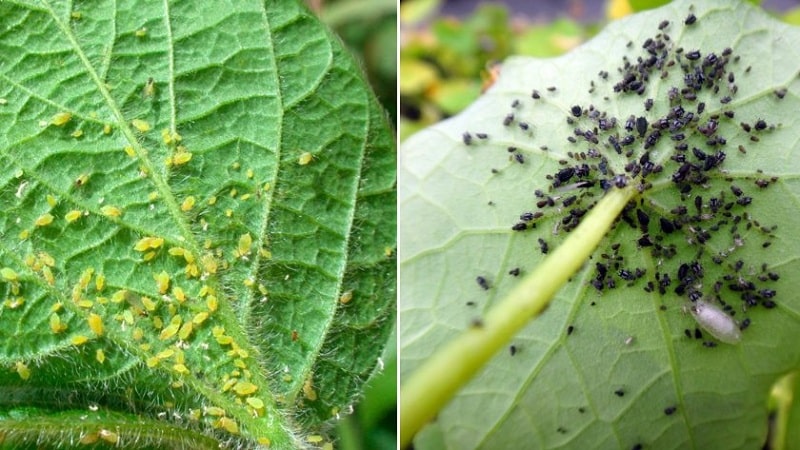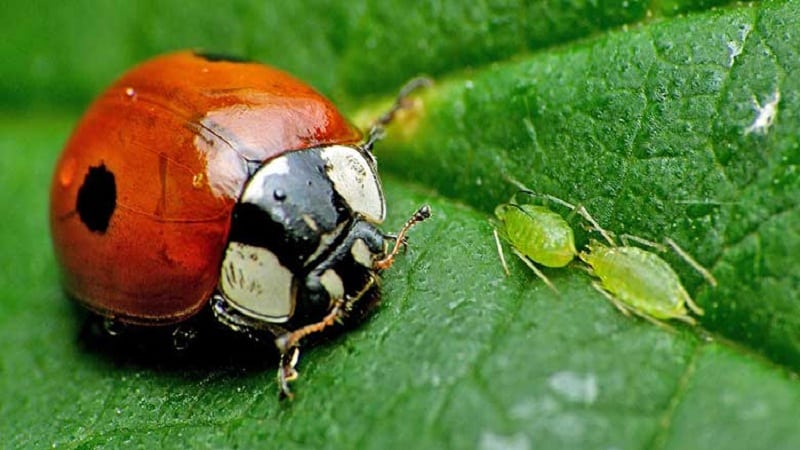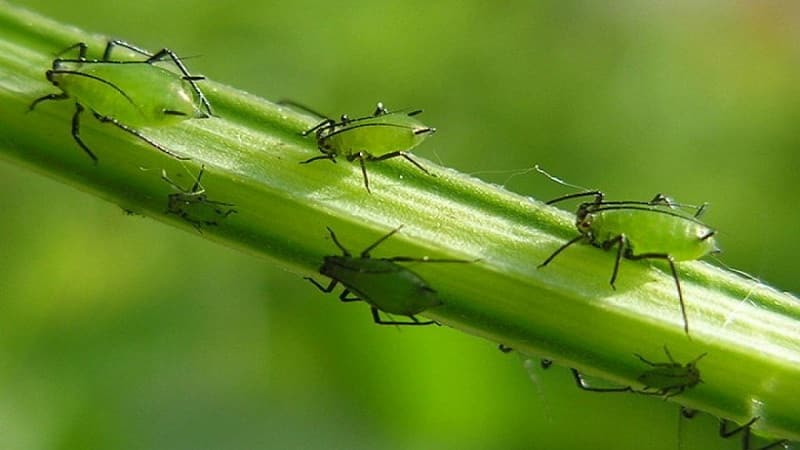How to fight aphids on cucumbers from the bottom of leaves: the most effective measures to save the crop
Bakhchevaya, or the cotton aphid has an exorbitant appetite and is capable of destroying the fruits of the efforts of gardeners in a few days if the fight against it is not started in time. Treatment with various solutions is difficult because the bugs hide on the back of the leaves, so the greens have to be sprayed especially carefully.
From the article you will learn what are the causes and symptoms of the appearance of aphids on cucumbers from the bottom of the leaves, how to fight them with the help of insecticides, biological products and home remedies based on herbs, soda, ammonia, and wood ash.
Causes of aphids
The first reason for the appearance of aphids on cucumbers is ants. They feed on sweet dew, which is formed as a result of the activity of pests and accumulates on the back of the leaves. Moving from place to place, the ants carry the larvae on themselves, spreading aphids throughout the area.
The second reason is violation of agrotechnical rules. Untimely weeding, dense planting of cucumbers, poor ventilation in the greenhouse, increased nitrogen content in the soil - all this contributes to the appearance of aphids on the site.
The bugs find shelter in dried weeds and plant remains from last season. Females intensify their activity in the spring, when the air warms up to +5°C. The ants carry the insects to young plants, where the females begin to lay eggs on the back of the leaves.
Symptoms of the lesion
At the initial stage of infection, it is difficult to see small bugs merging with the greenery. But as the aphids spread in the area, the first symptoms appear:
- plants are delayed in growth and development;
- flowering begins much later than expected;
- the upper leaves first wither, then dry and curl;
- droplets of liquid appear on the leaves - honey dew;
- a large number of ants appear on the site;
- the ovaries dry out and fall off;
- the lower leaves fade;
- the reverse side of the leaves seems to be covered with bugs of green or black color.
The photo shows cucumber leaves infected with aphids.

Damage dealt
As a result of inaction or ineffective pest control methods:
- cucumber seedlings die in 50% of cases;
- plants slow down in development, flowers and ovaries die off;
- plantings are affected by the cucumber mosaic virus, which is transmitted by aphids.
How to deal with aphids on cucumbers
What to do if aphids attack cucumbers? Pest control is a long and gradual process that requires patience. The most effective means are contact-intestinal insecticides and biological preparations with a paralytic effect.
Folk remedies help repel insects, but are not able to completely destroy them. Herbal decoctions and infusions, soda, vinegar and ammonia are used during the fruiting period. It is prohibited to use chemicals during this time.
Manual collection is the most labor-intensive and ineffective method. It is used for minor damage to plantings.
Chemicals
Chemical preparations help quickly and effectively get rid of the pest. Treatments are carried out until fruit ovaries appear. Leaves, roots and fruits instantly absorb toxic substances. Eating such cucumbers leads to poisoning of the body.
The table shows the chemicals and dosage.
| Name | Action | Application |
| "Decis" | Has a paralytic effect on the nervous system. | Dissolve 0.35-0.5 g of powder in 5 liters of water. Consumption - per 100 m². Carry out the treatment after sunset in dry, windless weather. |
| "Inta-vir" | A drug with a paralytic effect on the nerve cells of the pest. Protection lasts up to 15 days. | 1 table for 10 liters of water. Spray the bushes during the growing season. |
| "Aktara" | Paralyzes the insect's nervous system 30 minutes after penetration into the intestines. Protection for foliar treatment - 24 days, for root treatment - 60 days. | 250 ml of solution per 10 liters of water. Treat cucumbers once before flowering.
|
| "Tanrek" | It has a systemic toxic effect on the central nervous system of bugs. The protective period is 1 month. | 1.5 ml of substance per 1 liter of water. Mix the solution and add 4 liters of water. Consumption 10 l per 100 m². |
| "Danadim" | Systemic insecticide with contact-intestinal action, depressing the central nervous system of insects. Protection – up to 3 weeks. | Consumption 0.5-1 l per 1 ha. Carry out the treatment in the evening in dry weather. |
| "Confidor" | A drug with a paralytic effect. Protection lasts up to 30 days. | Dilute 1-2 g in 100 ml of water, then increase the volume to 10 liters. To treat 100 m², 1 ml of the drug is enough. |
Traditional methods
The action of natural remedies is aimed at repelling aphids. The table contains the most effective infusions and solutions.
| Name | Preparation and use |
| Marigold | Pour dried flowers into 10 liters of water and leave for two days. Strain and mix in 50 g of laundry or tar soap crumbs. |
| Yarrow | Pour 1 kg of fresh herbs into 5 liters of hot water. After two hours, add 10 liters of water and use to treat the plantings. |
| Celandine | Pour 0.5 kg of dry raw material into 10 liters of warm water and leave for two days. Spray the bushes with a spray bottle. |
| Mustard | 20 g of mustard beans pour 2 liters of warm water.Leave for two days and add 2 liters of clean water. |
| Dandelion roots | Chop 0.5 kg of fresh roots and add 5 liters of water. Leave for 2 hours and start spraying. |
| Hot pepper | Finely chop two peppercorns and add 10 liters of water. After a day, strain and mix in 50 g of laundry soap crumbs, 150 g of wood ash, 5-7 drops of iodine. Spray the bushes with a spray bottle. |
| Garlic | Chop 400 g of garlic arrows and pour 2 liters of warm water. Leave for 5-6 days, increase the volume to 10 liters and process the greens. |
| Horseradish | Grate 8-10 fresh roots on a fine grater, pour in 3 liters of hot water. Leave for 3-4 hours, strain, squeeze out the cake and pour 3 liters of warm water into it. Leave the liquid to infuse for three hours. Then add the concentrate remaining after straining. Before use, dilute 300 ml of infusion with 5 liters of water. |
| Onion peel | Pour 200 g of husk into 5 liters of warm water for 12 hours. Then add 20 ml of liquid soap and mix. Use liquid to spray plantings. |
| Tobacco dust | Pour 0.5 kg of shag into 10 liters of hot water. Leave for two days, add 50 g of soap shavings and mix thoroughly. |
| Wood ash | Pour 150 g of ash and 250 g of laundry soap crumbs into 10 liters of water. Shake and spray the bushes before use. |
| Soap solution | Dissolve 125 ml of liquid soap or 200 g of tar or laundry soap crumbs in 10 liters of warm water and immediately spray the cucumbers. |
| Soda | Dissolve 150 g of soda in 5 liters of warm water, add 20 drops of lavender essential oil and treat the plants. |
| Dairy products | Curdled milk, kefir, whey are slightly diluted with warm water and treated daily until the insects are completely eliminated. |
| Ammonia | Add 60 ml of ammonia, 50 ml of liquid soap to 10 liters of water and spray the bushes. |
| Vinegar | 200 ml of table vinegar 9%, 50 g of soap crumbs, pour 10 liters of water. Spray the cucumbers with a spray bottle. |
Biological methods
Biological agents are used throughout the growing season. The active components do not accumulate in greens and cucumbers and do not pose a danger to humans.
| Name | Action | Application |
| "Bitoxibacillin" | Once in the insect's intestines, the drug disrupts metabolic processes and blocks the flow of nutrients. | 80-100 g/10 l of water. Spraying during the growing season with an interval of 15-17 days. Consumption - 1-3 l/10 m². |
| "Aquarin" | Kills aphids in 48 hours. The action is aimed at blocking the flow of nutrients from the digestive tract. | 80 ml/10 l water. Treatment frequency is three times per season. |
| "Aktofit" | The toxin affects the central nervous system, completely immobilizing insects. Not addictive. | Consumption - 8 ml/1 l of water. Treatment frequency: twice per season. |
| "Fitoverm" | The active substance aversectin enters the body through the intestinal tract, causing paralysis. | 10 ml/1 l of water. The consumption rate is 1.5 liters for each bush. Treatment - twice per season. |
| "Entobacterin" | Has a nerve-paralytic effect. Completely destroys aphids in a week. | 10 g/1 l of water. Spray the bushes with a spray bottle. |
| "Arrow" | Contains bitoxybacillin spores. Insects lose the ability to feed. Destroys the pest in 10 days. | 50 g/10 l water. For better adhesion to the leaves, add 1 tbsp to the solution. l. dry milk or 25 ml of liquid soap. |
Agrotechnical techniques
Agrotechnical methods are aimed at increasing the protective powers of cucumbers and using environmentally friendly methods to combat aphids. The effectiveness of such methods is high when used comprehensively.
Agrotechnical practices:
- Attracting beneficial insects and birds: ladybugs, hoverflies, earwigs, lacewings, predatory wasps, sparrows, tits. To do this, marigolds, parsley, fennel, dill, cilantro, basil, cumin, oregano, and daisies are planted on the site. To attract birds, feeders and drinking bowls are hung.

- Planting plants to attract aphids and distract attention from cucumbers. Bugs prefer the tender greens of dill, sow thistle and legumes. Plants are sown along the beds. This technique involves the use of healthy seeds, timely application of fertilizers, proper watering, maintaining optimal temperature (+25...+30 °C during the day, +15...+18 °C at night) and humidity (70–80%) in the greenhouse.
- Preventive watering with infusion of nettle and tomato tops in June. The infusion repels aphids and saturates the soil with nitrogen.
Features of the fight against aphids in closed and open ground
To get rid of aphids in a greenhouse and in the garden they use the same chemical, biological, folk remedies and agrotechnical techniques. When working with chemicals, use respirators to protect the respiratory tract and long sleeves to protect the skin. Neglecting this rule risks serious poisoning of the body.
To increase immunity, plants are fed with potassium-phosphorus fertilizer (10 g of potassium sulfate, 20 g of superphosphate/10 l of water). Plantings are sprayed with the solution 1 time/10 days. Aphids are less likely to attack strong and healthy bushes.
In the fall, 10-15 cm of the top layer of soil in the greenhouse is removed or treated with copper-containing preparations and sulfur bombs.
They dig up the soil in an open area, weed out weeds, uproot old stumps, and get rid of anthills in which aphids overwinter.
Reference. Anthills are filled with Anteater or hot water, and the beds are regularly loosened to repel insects.
How to prevent aphids

To prevent infection of plantings by aphids, it is recommended:
- cultivate varieties and hybrids that are resistant to insects;
- close the windows and doors in the greenhouse with a mosquito net or gauze;
- cover plantings in open ground with thin agrofibre that allows air to pass through;
- simultaneously fight ants;
- get rid of weeds in a timely manner;
- treat the seed before embedding it in the ground;
- disinfect the soil with potassium permanganate, copper sulfate;
- in the fall, fumigate greenhouses with sulfur bombs;
- alternate bush treatments to prevent resistance;
- do not thicken plantings;
- Regularly fertilize cucumbers with potassium-phosphorus fertilizers.
Reviews
The problem of aphid infestation of cucumber plantings is familiar to many gardeners. Over the years of practice, everyone has determined for themselves the best method of pest control.
Andrey, Borisoglebsk: “At the first sign of aphids, I treat the bushes with Fitoverma solution. I dilute one ampoule in a glass of water and spray the leaves above and below, twice, with an interval of a week. It is important not to skimp on the solution and treat the leaves generously, especially on the back side.”
Inna, Stary Oskol: “Last year there was a real invasion of aphids. I have a negative attitude towards chemistry and do not use harmful drugs on my site. Therefore, I used a proven method. I take 1 kg of potato tops, pour in 10 liters of warm water and leave for five hours. Then I strain and add 1 tbsp. l. liquid soap. When sprayed, foam remains on the leaves and prolongs the effect of the solution. Remember that the tops are poisonous. If the concentration is exceeded, burns will appear on the leaves.”
Olga, Vyazma: “To fight aphids I use the old fashioned method. I add 100 g of wood ash to 10 liters of water and mix in 30-50 g of grated laundry soap. The product has never failed.”
Read also:
Aphids appeared on peppers in the greenhouse.
Aphids on tomatoes: how to fight during flowering and what means to choose.
Conclusion
Fighting aphids on cucumbers is not a quick task, especially when time is lost and the pest has managed to take over a large area. Experienced gardeners recommend carrying out the fight in a comprehensive manner, using agrotechnical techniques (sowing grass to attract beneficial insects, timely weeding, increasing plant immunity) and treatments with chemical, biological and folk remedies.
Spraying of plantings is carried out carefully, not forgetting to treat the leaves from below. After all, this is where aphids hide and actively reproduce. Insecticides are alternated with biological products and herbal infusions so as not to cause addiction. When carrying out chemical treatments, observe safety precautions, protecting the skin and respiratory organs.